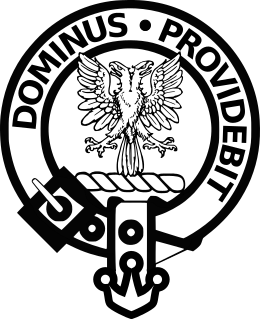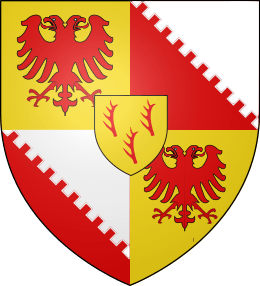Clan Boyle facts for kids
Quick facts for kids Clan Boyle |
|
|---|---|

Crest: A double headed eagle displayed, parted per pale embattled Gules and Argent
|
|
| Motto | Dominus providebit ("The Lord will provide.") |
| Profile | |
| Region | Lowlands |
| District | North Ayrshire |
| Chief | |
 |
|
| The Rt. Hon. Patrick Boyle | |
| The 10th Earl of Glasgow | |
| Seat | Kelburn Castle |
Clan Boyle is a historic Scottish clan that comes from the Scottish Lowlands. Clans are like big families or groups of people who share a common ancestor and a strong sense of identity. The Boyle family has a long and interesting history in Scotland.
Contents
History of Clan Boyle
Where the Boyle Name Comes From
The name Boyle first came from a Norman town called Beauville, which is near a city in France called Caen. The first record of someone named de Boivil in Scotland was in 1164. Later, in 1275, a person named Richard de Boyville owned land at Kelburn in Ayrshire.
Around 1291, Henry de Boyville was in charge of several important castles: Dumfries Castle, Wigtown Castle, and Kirkcudbright Castle. In 1296, Richard de Boyvil and Robert de Boyvil both signed the Ragman Rolls. This was a document where Scottish nobles agreed to be loyal to King Edward I of England. Richard Boyle also married the daughter of Sir Robert Comyn.
Clan Boyle in the 1400s and 1500s
Many years after Richard Boyle, his descendant, John Boyle, fought in the Battle of Sauchieburn in 1488. He was fighting to support King James III of Scotland and was sadly killed in the battle. Because of this, the family's lands were taken away. However, John's son, who was also named John, had the family lands given back to him by King James IV of Scotland.
During the time when Elizabeth I was Queen of England, the Boyle family supported Mary, Queen of Scots.
Clan Boyle in the 1600s and 1700s
In the 1600s, the Boyle family supported King Charles I of England. This caused them some difficulties. But their family's good fortune returned when John Boyle of Kelburn was chosen to be a Commissioner of Parliament. This meant he was a representative in the government.
John's oldest son, David Boyle, also became a Commissioner of Parliament. He was also made a Privy Councillor, which meant he advised the King. In 1699, David was given the title of Lord Boyle of Kelburn, making him a peer. In 1703, he was given an even higher title: Earl of Glasgow. He also helped create the Treaty of Union, which joined Scotland and England to form Great Britain.
During the Jacobite rising of 1715, David Boyle strongly supported the British government. He even paid for and armed his own soldiers to help.
John Boyle, 3rd Earl of Glasgow, chose a military career. He was injured in battle twice: first at the Battle of Fontenoy in 1745, and again at the Battle of Lauffeld in 1747. He was also appointed Lord High Commissioner to the General Assembly of the Church of Scotland, holding this important position for nine years in a row.
Clan Boyle in the 1800s
David Boyle, who was a grandson of the second Earl, became a very skilled lawyer. In 1807, he was made Solicitor General for Scotland, a top legal position. He later became a judge and, in 1841, was appointed Lord Justice General, the highest judge in Scotland. He retired in 1852 after working in law for 41 years.
George Boyle, the 4th Earl, also joined the military. He became a colonel and was appointed Lord Lieutenant of Renfrewshire in 1810. His oldest son, John, was a naval officer who was captured by the French near Gibraltar in 1807.
John's brother, James, became the fifth Earl in 1843. He had also served in the Royal Navy and was also made Lord Lieutenant of Renfrewshire.
James was followed by his half-brother, George Frederick Boyle. This period was difficult for the family. George Boyle loved art and architecture. He started a huge building project, fixing up Kelburn Castle and paying for churches across Scotland. By 1888, he had spent all the family's money, and their properties had to be sold. Kelburn Castle was only saved because his cousin, David, bought it. David later became the David Boyle, 7th Earl of Glasgow.
David Boyle became Earl in 1890 and was the Governor of New Zealand from 1892 to 1897. In 1897, he was given another title, Baron Fairlie, which was part of the Peerage of the United Kingdom. This was important because, at that time, only a few Scottish peers could sit in the House of Lords (the upper house of the British Parliament). This new title made sure he had a seat there.
Clan Boyle Today
The current chief of Clan Boyle is the 10th Earl of Glasgow, Patrick Boyle, 10th Earl of Glasgow. He used to be a naval reserve officer and an assistant TV director. He became the chief in 1984 after his father passed away. He lives at Kelburn Castle, which has been the family's home since the 1200s.
Clan Castles
- Kelburn Castle is the main home of the current chief, Patrick Boyle, 10th Earl of Glasgow.
- Rowallan Castle
See also

